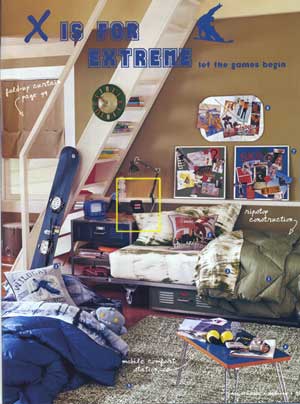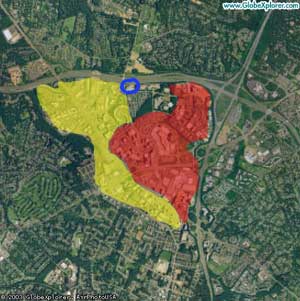
|
|
|
Friday 29 August 2003
Urban Planning
Fat and Sprawling The Washington Post’s August cavalcade of incredibly poorly-done articles continues apace with a page-three story this morning headlined Suburbia USA: Fat of the Land? The story concerns a report from the University of Maryland that shows that there is a correlation between the ‘sprawl index’ of where you live and how fat you are, on average. Presumably this is because people who live in certain places never walk anywhere, because there’s nothing to walk to. The ‘sprawl index’ is a number derived from doing calculations on a number of figures describing an area, including gross population density, percentage of the population living at less than 11500 people per square mile, percentage living at more than 12,500 people per square mile, average block size in square miles, and the percentage of ‘small’ blocks — under .01 square mile. I have a big problem with this ‘sprawl index’. The report — see it here — doesn’t mention precisely how all these figures go together to give the index, but the numbers don’t seem to make sense to me. To begin with, the sprawl index looks like some kind of weighted density rating; a higher number means less sprawl. Manhattan’s sprawl index, the highest in the country, is 352.07; Westchester County’s sprawl index is 128; Cook County, IL, is 150. Exactly what these numbers mean, except that Manhattan is 3.52 times as dense as the national average, and that Chicago is apparently twice as ‘sprawling’ as Manhattan, it’s hard to say. On top of that, the sprawl index makes absolutely no distinction between a dysfunctional, sprawling suburb, and open countryside. Loudoun County, VA, has a sprawl index of 94.57; Goochland County, VA an index of 67.59. Both of these must be awful places, right? Wrong. Both counties are largely multi-million-dollar horse farms, with small towns dotted here and there. The eastern edge of Loudoun County has its share of grotty suburbs, but in general the county is composed of the kinds of settlements that one would think anti-sprawl advocates would favor. It’s clear that if your goal was to build some pretty awful suburbs, but to get a low sprawl score, it’d be possible: just make the houses fairly dense (which they are already, actually), make the roads connect, and so on. It won’t mean anything for real walkability if your residential zoning ‘pods’ are ten miles across. The problem isn’t that people live at too low a density, exactly; it’s that they live in residential ghettos with nothing but other tract houses for miles around. All of that said, the study’s conclusions — that the suburbs, as they’re built now are a public health threat — are probably true. This is the first time I’ve seen this clearly stated from a non-crackpot source. Since you can justify almost anything these days by calling it a solution to a public-health problem, maybe this is the thin end of the wedge that will result in the human habitat being more, well, habitable in the future. Posted by tino at 17:29 29.08.03
Wednesday 27 August 2003
Rant
Police Can’t Direct Traffic For Toffee At around 5:00 p.m. today, a strong thunderstorm moved through the area around Tino HQ, and knocked out power to some areas. Traffic signals work on electricity, so this meant that a lot of intersections were without signals. This gave me the opportunity to once again note that cops, by and large, don’t know how to direct traffic any more. I think the police academy spends one afternoon on directing traffic, and then, because most cops don’t do it very often, they forget what’s necessary. The main thing is for the cop himself to be visible to the drivers of cars, and for his signals to be visible, clear, and unambiguous. The cop-visibility thing they’ve got down, with their flashing lights and reflective vests and all. But the rest they don’t seem to care too much about. Tonight, I came upon one intersection where a two-lane street crosses a four-lane divided highway with left-turn lanes on both sides. There were two cops there. Each one had parked his car at the far end of a left-turn lane, and had turned on the full complement of flashing lights. This conveniently blinded drivers arriving from either direction on the four-lane highway. That the drivers were blinded by all the blinking wasn’t particularly important, though, because these two jokers were standing out in the middle of the street, waving their flashlights at people. The cop would, from about fifty feet away, shine his flashlight in your face, and then aim it in the direction he wanted you to go. Of course, you couldn’t see this, and since he was just swiveling his wrist around and moving a black flashlight — and this at dusk — it didn’t work very well. When the police are directing traffic, traffic should actually move more quickly than it does when the electric signals are working. Even the signals with magnetometer car-detector loops in the pavement seem to make silly decisions; a human being on the scene should be able to do a much better job. Instead, though, cop-directed traffic usually seems to move at a snail’s pace, and I think it’s primarily because the drivers are squinting through their windshields, trying to read the cops’ minds — because their hand signals are hardly visible. Directing traffic effectively means waving your arms around in big movements, not making covert little hand gestures or waving flashlights. It’s possible that the police are just afraid of looking silly, windmilling about in the middle of the road. Since these are people with more stuff hanging from their belts than Batman, you’d think they’d have got over the fear of looking silly a long time ago. Posted by tino at 21:49 27.08.03
Tuesday 26 August 2003
Government Idiocy
EZ-Pass Compatibility ‘Useful’ After All From The Washington Post:
Funny, in November 2001, VDOT said that compatibility with EZ-Pass “…would not be very useful to Virginia’s motorists”. “Not very useful” in 2001, “good news for the driving public” less than two years later. I wonder who had to be paid off for VDOT to get out of the damned way? Posted by tino at 19:03 26.08.03
Monday 25 August 2003
General Idiocy
Ethnic Identity and Words The Washington Post today has a story about people who come from the Western Hemisphere, but south of the Rio Grande, and the problems they apparently have about what to call themselves.
If your big problem is that another member of your own ethnic group is using a word to describe him or herself that isn’t actually offensive but that you don’t like, you don’t have a problem. “People who use that word don’t know why they’re using it,” said Cisneros, a Mexican American poet and novelist. “To me, it’s like a slave name. I’m a Latina.” That declaration — “I’m a Latina” — is resounding more and more through the vast and diverse Spanish-speaking population that dethroned African Americans as the nation’s largest ethnic group a few months ago. However, this is only because ‘Hispanic’ isn’t the same kind of category as ‘Black’ or ‘White’ or ‘Asian’. (Also note how ‘African American’ is ‘ethnic’, but ‘European American’ or anything else involving ‘white’ people is not.) You can be Black, White, or Asian and still be ‘Hispanic’. Further, if all ethnic identities were accorded the same status as Hispanicity, you’d find that Germans are actually the largest ethnic group in the United States. It just doesn’t seem that way, because German-Americans aren’t constantly going on about how being German makes them special and different. And this article ran on the front page of the Post. Goes to show you what August brings in the news business. Anyway, what does the guy responsible for this hateful, hateful, ‘slave name’ word in the bookshop have to say?
He sounds like an American to me. Posted by tino at 22:15 25.08.03
Thursday 21 August 2003
General Idiocy
Parking Lot Silliness The scene is Wednesday, in a parking lot in Reston, Virginia. A new BMW 540i is pulling forward, out of a parking space. As it begins to turn down the aisle, a white Ford passenger minivan — the kind that’s full of windows — starts backing out of a nearby space, putting it on a collision course. The BMW stops dead, and the driver starts tootling with vigour. BMW: Toot! Toot! The minivan keeps coming. BMW: Toot! ToooooooooooooooooooooooooooooBAP The driver of the minivan, despite having nearly 360-degree visibility, despite having been moving at only about 1 mph, despite the fact that the BMW driver was laying on his horn, has managed to back into the BMW. The minivan pulls forward and parks a short distance away. Both drivers get out and inspect their vehicles for damage. Thanks to federally-mandated 5 mph bumpers, there’s no damage at all; thus society has been saved $1000 at a cost of mere millions. The BMW driver, a middle-aged man, looks disgusted, but the minivan driver, a fat woman who’d been blocking my access to the Coke machine at Jerry’s Subs and Pizza a few minutes earlier, is livid. She’s shouting, waving her arms, yelling at the man who’d been sitting with his foot on the brake and his fist on the horn as she drove into his car. Hell in a handbasket. Posted by tino at 16:59 21.08.03
Wednesday 20 August 2003
Random Interesting Thing
Domo Madness! So I was paging through the Pottery Barn Teen catalog — as I am wont to do — the other day, and I came across this:
Inside that yellow box is this:
Domo has been co-opted by the Pottery Barn people. Posted by tino at 20:29 20.08.03
Sunday 17 August 2003
Urban Planning
Park-and-Ride Lots as Transit Hubs There is little, it seems, that mass-transit officials like better than buses. Buses are great, after all; they’re incredibly cheap (when compared to trains), they’re easy to deploy, they don’t require expensive infrastructure, they can be reconfigured (i.e. the bus can follow a differing route, something that’s hard to do with a train), etc. Some people complain that the problem with the bus is that it can get caught in traffic just like a car, but you can fix this with bus lanes and ‘busways’, roads that only buses can use. This removes some of the flexibility and raises the cost of your bus system, but it’s still far more flexible and much cheaper than a rail approach. No matter what you do, though, people don’t much like buses. I don’t like them; I’ll very willingly ride a train, but I don’t think I’ve been on a bus in at least fifteen years. One problem might be that train stations tend to be hubs of activity, with lots of things to do, places to live, etc. right on top of them. Bus stops — the kind of bus stops I’m talking about here, where the express buses stop — are usually located with an eye to the buses’ convenience, not the convenience of the people riding the things. Tyson’s Corner, VA is, as always, a good example for How Not To Do It.
The Capital Beltway runs vertically on the right side of the picture, and VA-267, the Dulles Toll Road, horizontally across the top. The red area is predominantly (relatively) dense retail and office space. There are two large shopping malls, a few hotels, some high-rise office buildings, etc. The yellow are is less-dense office and retail space. It’s mostly strip malls, low-rise office buildings, car dealers, and so forth. Nearly all of the rest of the space in the picture is full of single-family houses, low-rise apartments, golf courses, and the like: classic low-density suburb. The bus station, of course, is circled in blue. It’s near the ‘medium density’ area, but on the very edge, and across a six-lane road from it. And I’m being pretty generous in calling this ‘medium density’. This station gets used, but really this is only because Washington-area traffic is so awful. Unless you happen to live or work immediately adjacent to the station, it’s not much use. Had this been built a mile away, in the middle of the dense area, it’d be useful to more than just commuters. If it were near anything, there would be increased ridership of the buses and traffic through the nearby stores, and the office and residential space nearby would be worth more. As it is, this isn’t the case, and because only a few buses a day stop here (partly because it’s a destination for almost no one), there isn’t even much of a boost to the immediately-adjacent property. I write about this because it appears that transit officials in Wisconsin, of all places, have noticed the problem, if in a small way. They plan to build some ‘commuter retail centers’. These don’t sound like they’ll be all that they could be, but they represent a big improvement over nothing.
Of course, the state is selling off the land to the developer, who’ll make all the money. If the DOT were to build a shopping center themselves — presumably they’d hire out the management of the thing — they might actually show a profit and be able to decrease or eliminate transit’s dependence on subsidies. Posted by tino at 16:54 17.08.03
Tuesday 12 August 2003
Tinotopia Update
Tinotopia on ‘Vacation’ Tino has been away from Tino HQ for a week, and he’s leaving for about another week starting tomorrow. While we are not promising that the next week will be free of updates, it’s likely that nothing much will be written until at least Sunday, 17 August. Posted by tino at 00:14 12.08.03
|


